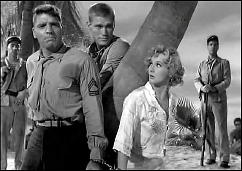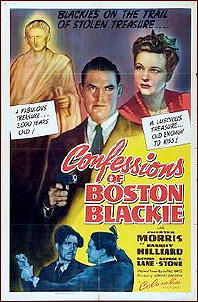BASIL HEATTER – A Night Out. Popular Library #771, paperback original; 1st printing, September 1956. A shorter version appeared in Manhunt, September 1954, as “The Empty Fort.”

For an author with a double dozen books to his credit, over a period of over three decades, there is not much known about Basil Heatter (1918-2009), except for one fact that is invariably mentioned whenever his name comes up.
Here, for example, is the biographical blurb about him that’s on the first page of the book in hand:
“Born on Long Island in 1918, Basil Heatter attended schools in Connecticut, then went abroad when he was 16 for a two year travel stint in Europe.
“Returning to America, he went to work for a New York advertising agency. During the war he served as skipper of a P.T. boat in the southwest Pacific.
“He is the son of Gabriel Heatter, the radio commentator, and at present he, Basil, is a news commentator for the Mutual Broadcasting System.”
That was in 1956. From CRIME FICTION IV: A Comprehensive Bibliography, 1749-2000, by Allen J. Hubin (2015), we learn just a little more:
“Born on Long Island, the son of radio commentator Gabriel Heatter; was advertising copywriter in 1970s living on a boat off Florida, and racing and chartering; died in Miami, FL.”

Heatter has thirteen books included in CFIV, one marginally, but at the moment A Night Out is not one of them, and it should be. The crime involved is not a major one, I grant you, not at the beginning, at least — that of smuggling some booze out of Cuba to shrimp boat skipper Johnny Flake’s home port of Key West — but small capers like this often run into trouble, matters escalate, and some people end up wounded or dead, and that’s exactly what happens here.
While this is criminous enough to suit most readers of this blog, I’d have to admit that most of the book consists of character studies of the players in it. All of them have a past, and events in the past have a way of making people who they are today. It takes awhile for their paths to converge, however, ending in a midnight shootout in an abandoned fort off the islands of Dry Torgugas, but the getting there is well worth it.
There are two women involved, Molly being the one that Flake let get away, and the other Jessica, is the promiscuous live-in lady friend of yachtsman Allan Chambers, who can’t live without her, but neither can he live with her. Another player is an old rummy named Cruze, who was at one time a terrific ship’s engineer, but it’s only because Flake needs someone in a hurry does he hire on the old man who’s now seriously afflicted with the shakes and an unquenchable thirst.
More than a crime novel, what this book is is pure noir. Most — not all — of the participants in the drama that takes place in this book are doomed, in one way or another. Most have no future, save what chance and pure luck give them. There’s little they can do to help themselves.
Although far from being in their league, Heatter channels F. Scott Fitzgerald and maybe Ernest Hemingway in this novel, more so than he does either of the two old standbys of Hammett and Chandler. While all but forgotten today, Heatter is more than adequate as a writer — he certainly knew his way around boats and the Gulf of Mexico — and he brings his characters enough to life that I know I’ll remember them all for a while to come.
John Payne could play Johnny, and Walter Brennan would be perfect as Cruze. Gail Russell could easily be Molly, but to tell you the truth, no matter what movie taking place in the 50s that I happen to be casting, there’d always be a part for Gail Russell.


